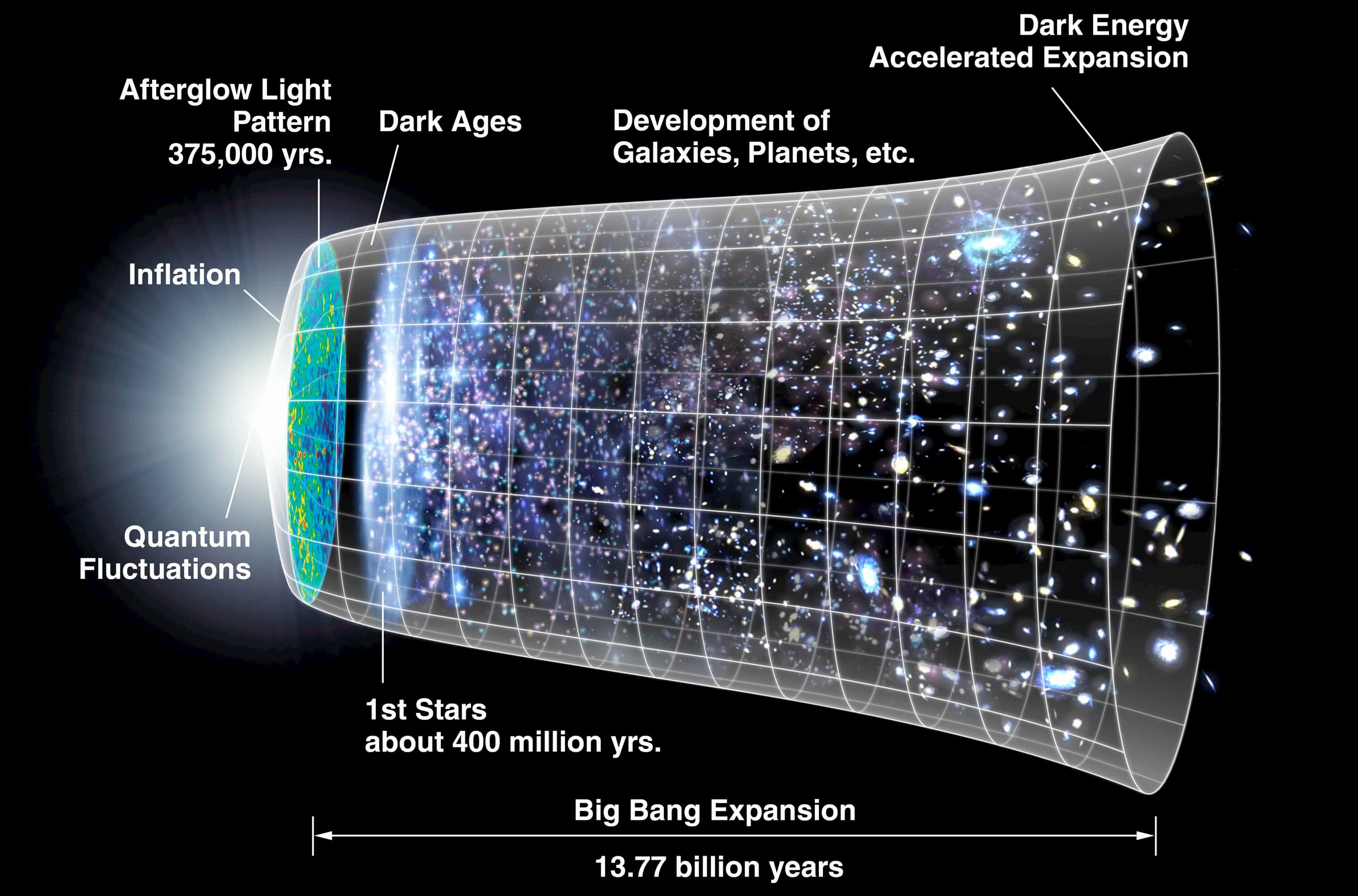Dark energy is a mysterious force that permeates our universe, driving its accelerated expansion and challenging our understanding of cosmology. Recent findings from the international Dark Energy Spectroscopic Instrument (DESI) collaboration, involving leading researchers like those from Harvard, indicate that this enigmatic energy, often described as a “cosmological constant,” may be evolving. This shift has profound implications for our current model of the universe’s expansion and physical processes governing galaxy evolution. As DESI charts the cosmos, it reveals how dark energy has influenced the universe over the past 11 billion years, prompting astrophysics research to reconsider its fundamental principles. With the detailed insights provided by DESI’s extensive 3D galactic surveys, the ongoing exploration of dark energy continues to reshape our knowledge of the universe’s fate and structure.
In the realm of astrophysics, the term “cosmic energy” is frequently synonymous with dark energy, the elusive force thought to be propelling the universe’s rapid expansion. Observations from the Dark Energy Spectroscopic Instrument, or DESI, play a pivotal role in unraveling the complexities of this energy, frequently referred to as the cosmological constant, and its interactions with cosmic matter. As this global scientific initiative advances, researchers are delving into how variations in cosmic energy may influence the evolution of galaxies and the large-scale structure of the universe. This critical investigation not only augments our grasp of galactic dynamics but also sparks discussions on the foundational theories of cosmology. As DESI continues its mission, it lays the groundwork for future discoveries and a deeper comprehension of the cosmos.
Understanding Dark Energy in the Cosmos
Dark energy remains one of the most enigmatic and compelling aspects of modern astrophysics research. As a driving force behind the universe’s accelerating expansion, dark energy is often equated with the cosmological constant, a term introduced by Albert Einstein. Recent findings from the DESI collaboration suggest that this force might not be constant after all, opening a Pandora’s box of questions about its true nature and implications for the future of the universe. The analysis conducted by CfA astronomers has indicated a potential weakening of dark energy’s influence over time, which could challenge the foundational models of cosmology that describe the universe’s evolution.
The significance of dark energy extends beyond just understanding the universe’s expansion; it directly impacts how structures like galaxies evolve and interact. With DESI’s enormous data set, which includes over 14 million galaxies and quasars, researchers can observe how dark energy influences matter distribution in the cosmos. The findings suggest that as we delve further into the intricacies of dark energy, we may uncover new insights that reshape our understanding of galaxy formation and the overall fate of the universe.
The Impact of DESI Collaboration on Cosmological Research
The Dark Energy Spectroscopic Instrument (DESI) represents a remarkable global collaboration among over 900 researchers across 70 institutions, all working together to decode the mysteries of the universe. This initiative not only aims to track dark energy but also offers deep insights into the structure and expansion of the universe. By utilizing the largest 3D map of the cosmos, DESI has been able to analyze the matter’s distribution and how it relates to the effects of dark energy over the past 11 billion years, focusing on historic cosmic patterns known as Baryon Acoustic Oscillations.
Such extensive research elucidates the underlying connections between cosmic phenomena, functioning like a cosmic ruler that helps measure the universe’s expansion. The revelations stemming from DESI have the potential to alter existing theories in astrophysics, especially regarding how dark energy interacts with matter and influences galaxy evolution. As this collaboration continues to produce groundbreaking findings, it stands at the forefront of reshaping our scientific understanding, essentially driving a new wave of cosmological exploration.
The Future of Galaxy Evolution Explored Through DESI
With the ongoing analysis from DESI, researchers are making strides in understanding galaxy evolution, a key component of astrophysics research. By creating comprehensive maps of the universe, astronomers can now track the history and interaction of galaxies over billions of years. The insights gained from studying galaxy formation patterns in relation to dark energy can help clarify how galaxies influence one another, evolve, and ultimately coalesce into larger structures. This interconnectedness between dark energy and galaxy evolution brings an exciting dimension to the field, prompting further investigation into the life-cycle of galaxies.
Moreover, as DESI continues to monitor the universe, it also nurtures a platform for interdisciplinary collaboration among various fields of research, including physics, astronomy, and computer science. The algorithms and simulations being developed by researchers like Harvard’s Daniel Eisenstein exemplify the innovative approaches being undertaken to analyze the complex data sets provided by DESI. The collaboration not only injects new theoretical paradigms into astrophysics but also inspires the next generation of scientists to explore the cosmos on a deeper level.
Baryon Acoustic Oscillations: A Cosmic Ruler
Baryon Acoustic Oscillations (BAO) serve as a powerful tool in cosmological research, functioning as a vital cosmic ruler that helps researchers measure the rate of the universe’s expansion accurately. These oscillations were caused by sound waves in the early universe, leaving imprints on the distribution of galaxies that can still be detected today. By utilizing data from DESI, scientists can analyze the size and scale of these oscillations over different epochs, thus providing critical data on how dark energy has influenced the cosmos through time.
As data accumulate from more than 14 million celestial objects, the BAO patterns become increasingly clear, allowing researchers to gauge the dynamics of dark energy further. This cosmic ruler not only aids in understanding the universe’s structure and evolution but also influences theories surrounding the Big Bang and the formation of galaxies. The methodical study of BAO is revealing the subtle ways in which dark energy has interacted with matter, essentially refining our understanding of both phenomena as we push the boundaries of cosmological knowledge.
New Challenges in the Standard Cosmological Model
The revelations concerning dark energy’s potential changes compel astronomers and physicists to reevaluate the standard model of cosmology, which has predominantly relied on the premise of a constant dark energy density. Findings from the DESI collaboration suggest that the properties of dark energy may not be static but could evolve, which presents significant challenges to established theories. This calls for new theoretical frameworks that can accommodate these observational insights and potentially lead to a transformative shift in our understanding of physics at cosmic scales.
The implications of a changing dark energy landscape are profound, impacting our predictions about the future of the universe and its eventual fate. As oscillations in dark energy become more apparent through continued observation and data collection, the scientific community must adapt to these changes by developing alternative models that accurately represent this dynamic universe. Researchers are now faced with the exciting yet daunting task of forging new paths in cosmology that account for the intrinsic interactions between dark energy, galaxy formation, and cosmic structure.
Galactic Structures: Insights from DESI Data
As the DESI continues to expand its cosmic map, researchers are gaining invaluable insights into the structure of galaxies and the broader cosmic web. This web represents the vast network through which galaxies interact, form clusters, and evolve over cosmic time. DESI’s detailed data allows astronomers to track these interactions and comprehend how dark energy influences these galactic structures and their growth. The observational evidence helps assess whether dark energy plays a role in regulating the formation and distribution of galaxies in the universe.
Investigating the structural aspects of galaxies not only enhances our contextual understanding of dark energy but also informs how galaxy evolution takes place across different cosmic scales. The ongoing analysis of galactic structures can yield answers to long-standing questions such as the formation mechanisms behind galaxies and how they shoot through gravitational interactions within the cosmic web. As these studies progress, they will likely unveil deeper correlations between dark energy and the very fabric of the universe, leading to new discoveries about cosmic dynamics.
The Role of Technology in Astrophysics Research
The advancement of technology has played an indispensable role in enhancing astrophysics research, particularly through initiatives like DESI. By employing cutting-edge tools and methodologies, researchers can capture detailed astronomical data that was once thought impossible. The technological prowess exhibited in constructing the largest 3D map of the universe is a testament to human ingenuity and collaborative efforts among international teams. This intricate infrastructure is essential for monitoring dark energy and exploring its implications for galaxies and the universe.
Moreover, the integration of technology in astrophysics is not limited to observational capabilities; it also extends to data analysis and simulation. Researchers at the Center for Astrophysics employ sophisticated algorithms to decipher massive datasets generated by DESI. This empowers scientists to not only gain insights into cosmic phenomena but also predict future trends in cosmic expansion influenced by dark energy. As technology continues to advance, we can expect deeper explorations into the complex interrelationships involving dark energy, matter, and the evolution of the universe.
Exploring the International Collaboration of DESI
The success of DESI is attributed to the extensive international collaboration among researchers, physicists, and institutions worldwide. This cooperative effort enables the pooling of diverse expertise and resources to tackle challenging questions in astrophysics. The involvement of noted institutions and researchers amplifies the collective knowledge and drives innovative approaches to studying dark energy and cosmic expansion. It reflects the modern trend of transdisciplinary collaboration, where skill sets from various domains combine to address complex scientific mysteries.
Moreover, the shared ambition and objectives of the DESI collaboration have paved the way for significant advancements in the scientific community. Through mutual support, information exchange, and collaborative brainstorming, researchers have created a rich environment conducive to breakthroughs. As DESI continues its work in unraveling the universe’s secrets, this extensive collaboration showcases how unified efforts can lead to groundbreaking discoveries, reinforcing the importance of teamwork in the field of science.
Public Engagement and Outreach in Astrophysics
As part of its mission, the DESI collaboration emphasizes the importance of public engagement and outreach. By disseminating their findings and making data accessible, researchers hope to inspire interest and curiosity about the universe among the general public. Visual materials and educational resources developed by collaboration members, including those at the Center for Astrophysics, serve to bridge the gap between complex scientific concepts and public understanding, fostering a greater appreciation for the astronomical discoveries that shape our knowledge of the cosmos.
Engaging the public in discussions about dark energy, galaxy evolution, and the overall mechanics of the universe not only enhances awareness but also encourages future generations to pursue careers in science and technology. The commitment of DESI researchers to education and outreach demonstrates their dedication, recognizing that the key to advancing scientific knowledge is also rooted in cultivating interest and enthusiasm in the broader community. As they continue to share their exciting discoveries, the journey into the depths of the universe becomes a collective adventure.
Frequently Asked Questions
What role does dark energy play in the expansion of the universe?
Dark energy is considered the primary force driving the accelerating expansion of the universe. It is believed to comprise about 68% of the cosmos and opposes the gravitational attraction of matter, influencing how galaxies evolve and positioning itself as a key factor in cosmological models, including the widely accepted cosmological constant.
How is the DESI collaboration working to understand dark energy?
The Dark Energy Spectroscopic Instrument (DESI) collaboration gathers extensive data to analyze the distribution of dark energy across the universe. By creating the largest 3D map of the cosmos over the past 11 billion years, researchers investigate how dark energy’s properties may have changed, using information from more than 14 million galaxies and quasars.
What recent findings about dark energy were presented by the DESI collaboration?
Recent analyses from the DESI collaboration suggest that dark energy, traditionally viewed as a cosmological constant, might be weakening over time. These findings indicate a potential shift in our understanding of the universe’s dynamics, compelling scientists to reassess the standard model of cosmology.
What implications do changes in dark energy have for galaxy evolution?
Changes in dark energy can significantly affect the evolution of galaxies by altering the expansion rate of the universe. As dark energy’s influence shifts, it could alter the structure and formation of galaxies, thus impacting their distribution and growth over cosmic time.
How do Baryon Acoustic Oscillations relate to dark energy research?
Baryon Acoustic Oscillations (BAOs) serve as a cosmic ruler in dark energy research. By analyzing the patterns of matter distribution established during the early universe, scientists can measure changes in the universe’s expansion rate, providing insights into the nature and evolution of dark energy over millions of years.
Why is the analysis of dark energy crucial for the future of astrophysics research?
Understanding dark energy is paramount for astrophysics since it is fundamental to the ultimate fate of the universe. Insights gained from dark energy studies inform theories on cosmic evolution, structure formation, and may lead to new physics beyond current models.
What datasets are available from the DESI collaboration for researchers?
The DESI collaboration has released its Data Release 1, which includes detailed observations of millions of celestial objects. This dataset is available to the public and will support a variety of astrophysical research projects, enhancing our understanding of dark energy and the universe’s structure.
| Aspect | Details |
|---|---|
| Collaboration | The Dark Energy Spectroscopic Instrument (DESI) involves over 900 researchers from more than 70 institutions worldwide. |
| Purpose | To study the influence and properties of dark energy using a vast 3D map of the universe. |
| Key Findings | Dark energy may be weakening over time, prompting a potential update to the standard cosmological model. |
| Methodology | Analyzed data from over 14 million galaxies and quasars to measure Baryon Acoustic Oscillations. |
| Significance | The findings may indicate unforeseen changes in dark energy’s effects on the universe’s expansion. |
| Outreach | The collaboration shares data and findings through publications and a public dataset accessible for research. |
Summary
Dark energy is a fundamental concept in cosmology that influences the expansion of the universe. Recent findings from the Dark Energy Spectroscopic Instrument (DESI) collaboration suggest that dark energy may not be constant as previously thought, leading scientists to reconsider theories about the universe’s fate. This collaborative effort highlights the importance of ongoing research in unraveling the mysteries of dark energy and its role in cosmic evolution.



